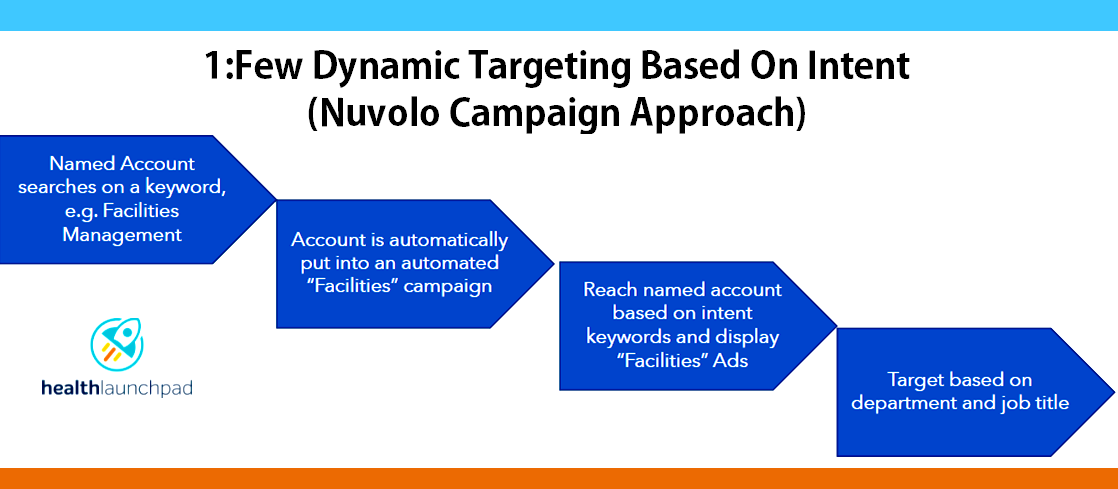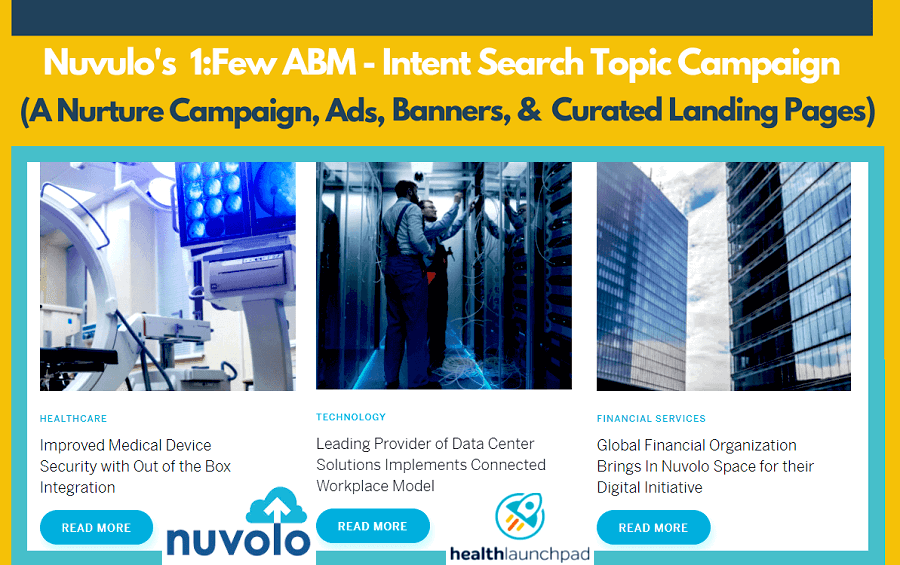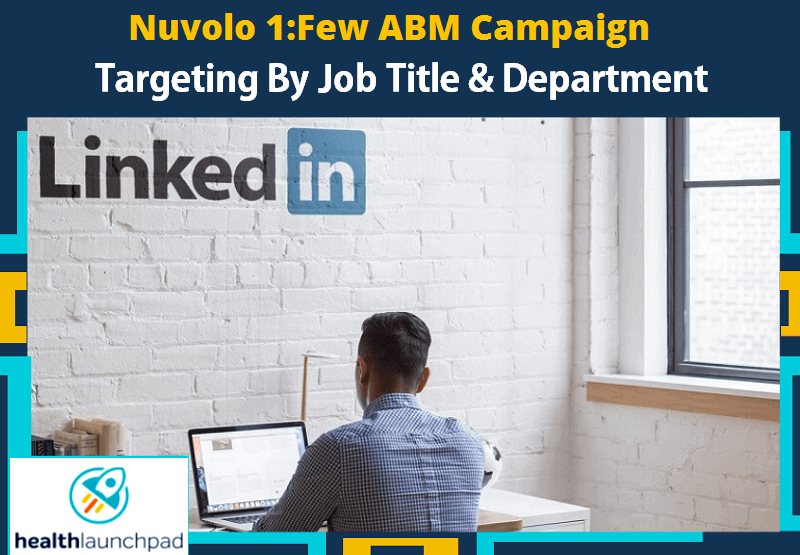This is part 4 of the 5 series post of Nuvolo’s ABM Case study. In the past posts, I shared who Nuvolo is and why they use ABM. I also covered their ABM strategy, and how they use 1:1 ABM. In this post, I shall detail Nuvolo’s 1:Few Marketing Campaign Approach.
What’s One-to-Few ABM?
1: Few or One-to-few campaign is a form of ABM, and is also referred to as segment-based ABM.
In this ABM approach, you target accounts in clusters of typically 50-100 accounts for your planned campaign.
You group the accounts based on a key parameter or profile that they all share.
This is important since each cluster will be targeted by your specific and relevant campaign.
According to ITSMA’s definition, 1:Few ABM is developing and implementing a customized campaign for account clusters with shared needs or areas of interest.
For most people, 1:Few marketing means that you are targeting clusters of accounts based on certain segment characteristics, or profiles.
Example For Healthcare Organizations:
If you target Healthcare organizations, you might create 2 campaign clusters.
For example, mid-size regional healthcare systems would be cluster #1 and #2 could be regional clinically integrated networks that are actively engaged in value-based care.
If you use intent data, you might also segment accounts based on their interest in certain topics.
For example, patient engagement could be one cluster and patient communications might be another.
Let’s explore how Nuvolo implements this ABM approach.
Nuvolo’s Approach To 1:Few Marketing

Nuvolo’s implementation of the 1:Few Marketing campaign is especially interesting in its use of intent data.
Intent data enables Nuvolo to identify accounts that are showing interest in areas where Nuvolo has an offering.
This enables Nuvolo to focus marketing efforts on accounts searching for clusters of topics related to their particular set of solutions.
For instance, after they identify best-fit accounts searching for intent topics that relate to Facilities Management, they then place them in a segment.
They will then target that segment with messaging and content about their Facilities Management solutions.
Here are the steps in the process.
Targeting Based On Intent Topics
Let’s take this Facilities Management example a bit further.
But first, here is another marketing term that you ought to understand.

In their Terminus system, they identity accounts that are “surging” for Facilities Management.
What does surging mean?
According to Bombora: Company Surge® identifies when a business is increasing research activity or content consumption on a product or service compared to its historical baseline. This is a strong indicator of B2B purchase intent.
How Nuvolo Targets “Surging” Accounts
When Nuvolo, identifies accounts that are “surging” for Facilities Management, the following happens:
They drop the accounts into a nurture campaign. They implement this in Hubspot.
Nuvolo’s sales team then uses the nurture campaign to engage these accounts.
A nurture campaign focuses on building a relationship with their lead, potential customer, or prospect.
They execute this using email sequence and extra attention by their Sales Development Reps (SDRs)
Apart from a nurture campaign, Nuvulo will also target their named accounts with display ads that are based on the intent keywords that the individuals within that account are searching for.
Targeting Individuals at Surging Accounts Based on Job Titles & Departments
Nuvolo’s 1:Few nurture campaign targets prospective champions and influencers at these in-market accounts based on Job titles & Departments.
For illustration, let’s say that Penn Medicine is one of their key accounts.
Here is what Nuvolo does:
First, when they identify that people from Penn Medicine (our example) are searching around Facilities Management, the account is dropped into their Facilities Campaign Cluster.
Nuvolo will then target people or accounts based on their Job Titles or Departments that are related to Facilities Management.

In this instance, they run a targeted ads campaign via LinkedIn.
Illustrative Examples:
Some of the Job Titles related to Facilities Management that Nuvolo would target in this campaign are Real Estate Manager, Workplace Manager, Office Services Manager, etc.
The department that will also appeal to their Facilities Management campaign are Project Management, Space Planning Department, Security, Building Operations Dept, Finance Dept, Building Operations, etc
When target accounts respond to the ads or email outreach, they are sent to a segment-specific landing page.
Nuvolo customizes the landing page to a particular target segment.
Content is curated around the topics that the segment has shown interest in.
This includes product information, blogs, videos, white papers, and other content that is specifically about Facilities Management.
Lessons To Learn From Nuvolo’s 1:Few ABM
Nuvolo’s 1:Few Marketing campaign approach helps it target buyers at best-fit accounts.
It’s part of a discipline to focus resources on those who are in-market and most likely to buy their solutions.
And so, through Intent keywords, Job titles, and Department targeting approaches, Nuvulo targets champions, decision-makers, or key stakeholders within their key segments.
They also reach those who can either directly or indirectly influence purchase decisions at in-market accounts.
Because of this strategy, Nuvulo’s 1:Few ABM approach has helped improve its marketing efficiency and performance.
What’s Next?
In my next post which will be the last on Nuvolo’s ABM Case study, I shall detail Nuvolo’ss 1:Many ABM Approach.
Other Relevant Links
- Nuvolo’s 1:1 Campaign Approach
- Nuvolo’s 1: Many Campaign – Case Study
- Simple Approaches to Simple Marketing Strategies
- How To Improve Your Marketing Message
- Building a Top Healthcare Technology Brand
- The perspective of a Healthcare IT Solutions Buyer
- The Use & Benefits of ABM

